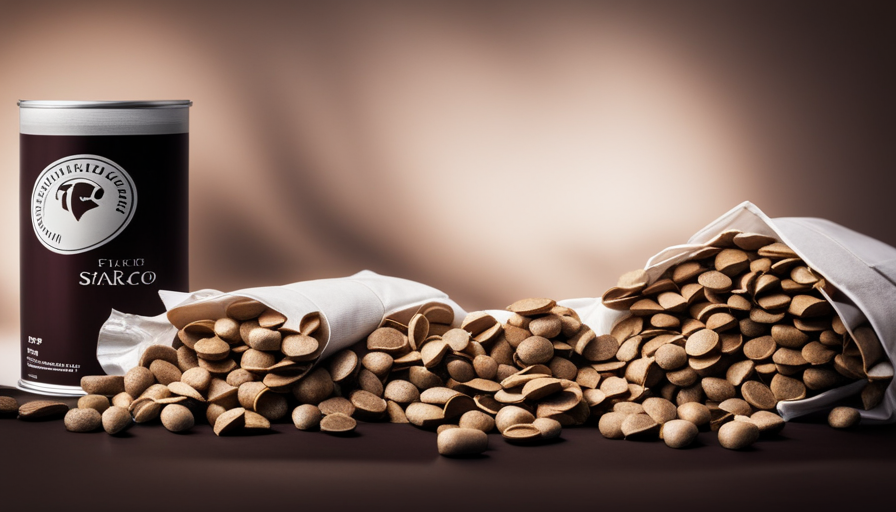For coffee lovers, the search for the ideal cup of coffee is a continuous journey. In the wide world of choices, Stumptown Cold Brew coffee has become a favored option. Yet, the caffeine levels in this beloved drink have always been a puzzling aspect for many.
Today, we unveil the truth behind the caffeine content of Stumptown Cold Brew coffee, shedding light on its potency and comparing it to other well-known brands.
Stumptown Cold Brew offers a range of products, each with varying levels of caffeine. The original Stumptown Cold Brew contains 279 mg of caffeine in a 10.5 fluid oz. bottle, while the Cold Brew concentrate boasts a staggering 470 mg in an 8 fluid oz. serving. Comparatively, other brands such as Death Wish Cold Brew and Chameleon Cold Brew offer their own caffeinated delights, with varying degrees of intensity.
It is important to note that the caffeine content in Cold Brews can be influenced by factors such as coffee beans, brewing time, and serving size. By delving into these intricacies, we aim to provide a comprehensive understanding of the caffeine content in Stumptown Cold Brew coffee.
Join us on this journey of discovery, as we uncover the secrets behind your morning cup of Stumptown Cold Brew.
Key Takeaways
- Stumptown Cold Brew coffee has varying levels of caffeine depending on the specific product, with the Original Cold Brew containing 26.57 mg of caffeine per fluid oz.
- Stumptown Cold Brew has a lower caffeine content compared to other well-known Cold Brew brands like Death Wish and Chameleon.
- The caffeine content in Stumptown Cold Brew products ranges from 247 mg to 470 mg, with the least caffeinated options being the Cold Brews with Milk, Chocolate Milk, Winter Cheer, Chocolate Oatly, and Horchata Oatly.
- The caffeine content in Cold Brews is influenced by factors such as coffee beans, brewing time, serving size, and water temperature used.
Caffeine Levels in Stumptown Cold Brews
The caffeine content of Stumptown Cold Brews varies depending on factors such as brewing time, serving size, and coffee beans used.
Stumptown offers a range of Cold Brew products, each with its own caffeine content. The Original Cold Brew, steeped for 8 to 24 hours, contains 279 mg of caffeine in a 10.5 fluid oz. bottle, resulting in 26.57 mg of caffeine per fluid oz.
The least caffeinated options are the 11 fluid oz. Cold Brews with Milk, Chocolate Milk, Winter Cheer, Chocolate Oatly, and Horchata Oatly, all containing 247 mg of caffeine.
On the other hand, the most caffeinated product is the 8 fluid oz. Cold Brew concentrate with 470 mg of caffeine.
It is important to note that the caffeine content in Cold Brews can impact the sensory experience, as different levels of caffeine can affect taste, aroma, and overall enjoyment of the beverage.
Comparison to Other Cold Brews
When comparing the caffeine levels of Stumptown Cold Brew to other well-known brands, it becomes evident that Stumptown Cold Brew falls on the lower end of the spectrum. Here is a comparison of the caffeine content in popular cold brew brands:
-
Stumptown Cold Brew (Original): Contains 279 mg of caffeine in a 10.5 fluid oz. bottle, which amounts to 26.57 mg of caffeine per fluid oz.
-
Stumptown Cold Brew with Oatly: Contains 247 mg of caffeine.
-
Death Wish Cold Brew: Contains 300 mg of caffeine in an 8 fluid oz. can.
-
Chameleon Cold Brew: Contains 520 mg of caffeine per bottle of 8 fluid oz.
-
Starbucks Nitro Cold Brew: Contains 215 mg of caffeine in a 12 fluid oz. serving.
With its lower caffeine content, Stumptown Cold Brew offers a more mindful approach to morning coffee. Cold brew coffee, in general, has health benefits such as lower acidity and a smoother taste due to longer brewing times. So, for those looking to enjoy the sensory experience of cold brew while moderating their caffeine intake, Stumptown Cold Brew is a great option.
Factors Affecting Caffeine Content
Factors such as the type of coffee beans, grind size, brewing time, serving size, and water temperature all play a role in determining the caffeine levels in cold brew beverages. The type of coffee beans used can vary in caffeine content, with some beans naturally containing more caffeine than others. The grind size affects the surface area of the coffee particles, which can impact the extraction of caffeine during the brewing process. Brewing time also affects caffeine levels, as a longer brewing time allows for more caffeine to be extracted. Additionally, the serving size of the cold brew can impact the caffeine content, with larger servings containing more caffeine. It is important to note that the water temperature used during brewing can also influence caffeine extraction. Overall, these factors contribute to the varying caffeine content in cold brew coffee.
| Factors Affecting Caffeine Content | ||
|---|---|---|
| Type of coffee beans | Grind size | Brewing time |
| Serving size | Water temperature |
Frequently Asked Questions
What makes Stumptown Cold Brew different from other cold brew coffees?
Stumptown Cold Brew stands apart from other cold brew coffees due to its unique flavor profile and meticulous brewing process.
The flavor of Stumptown Cold Brew is a result of carefully selected coffee beans, precise grind size, and the use of cold or room temperature water for a lengthy steeping period.
This brewing method allows the coffee to develop a smooth, rich taste with subtle notes of sweetness and acidity.
The attention to detail and commitment to delivering a full sensory experience make Stumptown Cold Brew a standout choice for coffee enthusiasts.
How does the caffeine content in Stumptown Cold Brew compare to regular hot brewed coffee?
The caffeine content in Stumptown Cold Brew varies depending on the specific product. Stumptown Original Cold Brew contains 26.57 mg of caffeine per fluid oz, while Stumptown Cold Brew with Oatly and some other flavors have 247 mg of caffeine per serving.
In comparison to regular hot brewed coffee, Stumptown Cold Brew generally has a higher caffeine content. However, it is important to note that the taste profile of cold brew is different from hot brewed coffee due to the different brewing methods and extraction processes.
Does Stumptown Cold Brew offer any decaffeinated options?
Stumptown Cold Brew, known for its rich and flavorful coffee, ironically does not offer any decaffeinated options. While the brand focuses on delivering a full sensory experience and allows for caffeine customization with varying levels of caffeine in their products, they do not cater to those seeking a caffeine-free alternative.
Stumptown Cold Brew’s emphasis is on providing a mindful and invigorating morning coffee experience, making it a popular choice among caffeine enthusiasts.
Are there any health benefits associated with consuming Stumptown Cold Brew?
Stumptown cold brew coffee offers a unique sensory experience for coffee lovers, but it is important to consider its potential health benefits and risks.
Compared to traditional hot brewed coffee, Stumptown cold brew may be perceived as a healthier alternative due to its lower acidity and potentially smoother flavor. However, it is essential to note that cold brew coffee still contains caffeine, which can have both positive and negative effects on the body.
Some potential benefits of consuming Stumptown cold brew include increased alertness, improved mood, and enhanced cognitive function. However, excessive caffeine intake can lead to side effects such as insomnia, restlessness, increased heart rate, and digestive issues.
It is crucial to consume Stumptown cold brew in moderation and be mindful of individual caffeine sensitivities.
Can I customize the caffeine content in my Stumptown Cold Brew by adjusting the brewing time or serving size?
The caffeine content in Stumptown Cold Brew coffee cannot be customized by adjusting the brewing time or serving size. The caffeine content is primarily determined by the coffee beans, grind size, and water temperature used during the steeping process. While adjusting the brewing time or serving size may affect the overall flavor and strength of the coffee, it will not significantly change the caffeine content.
Therefore, if you are looking to customize your caffeine intake, it would be more effective to choose a different cold brew brand or product with a lower or higher caffeine content.
How Does the Caffeine Content of Mountain Dew Compare to Stumptown Cold Brew Coffee?
When it comes to the caffeine showdown: Mountain Dew vs. coffee, there’s no question that Stumptown cold brew coffee takes the lead. With a higher caffeine content compared to Mountain Dew, this cold brew provides a stronger and more sustained energy boost. For those looking for a pick-me-up, Stumptown cold brew is the clear winner.
Conclusion
In conclusion, the caffeine content of Stumptown Cold Brew coffee varies across its different products. The original Stumptown Cold Brew has a lower caffeine content compared to other well-known Cold Brews. The Stumptown Cold Brew with Oatly and other offerings have a slightly lower caffeine content.
However, the Cold Brew concentrate is the most caffeinated option. When compared to other popular brands, Stumptown Nitro Cold Brew falls in the middle range of caffeine content, while Death Wish Cold Brew has a lower caffeine content. Chameleon Cold Brew has the highest caffeine content.
It is important to consider factors such as coffee beans, brewing time, and serving size when determining caffeine levels. With its commitment to a full sensory experience and a mindful approach to coffee, Stumptown Cold Brew offers coffee lovers a unique and flavorful option.










